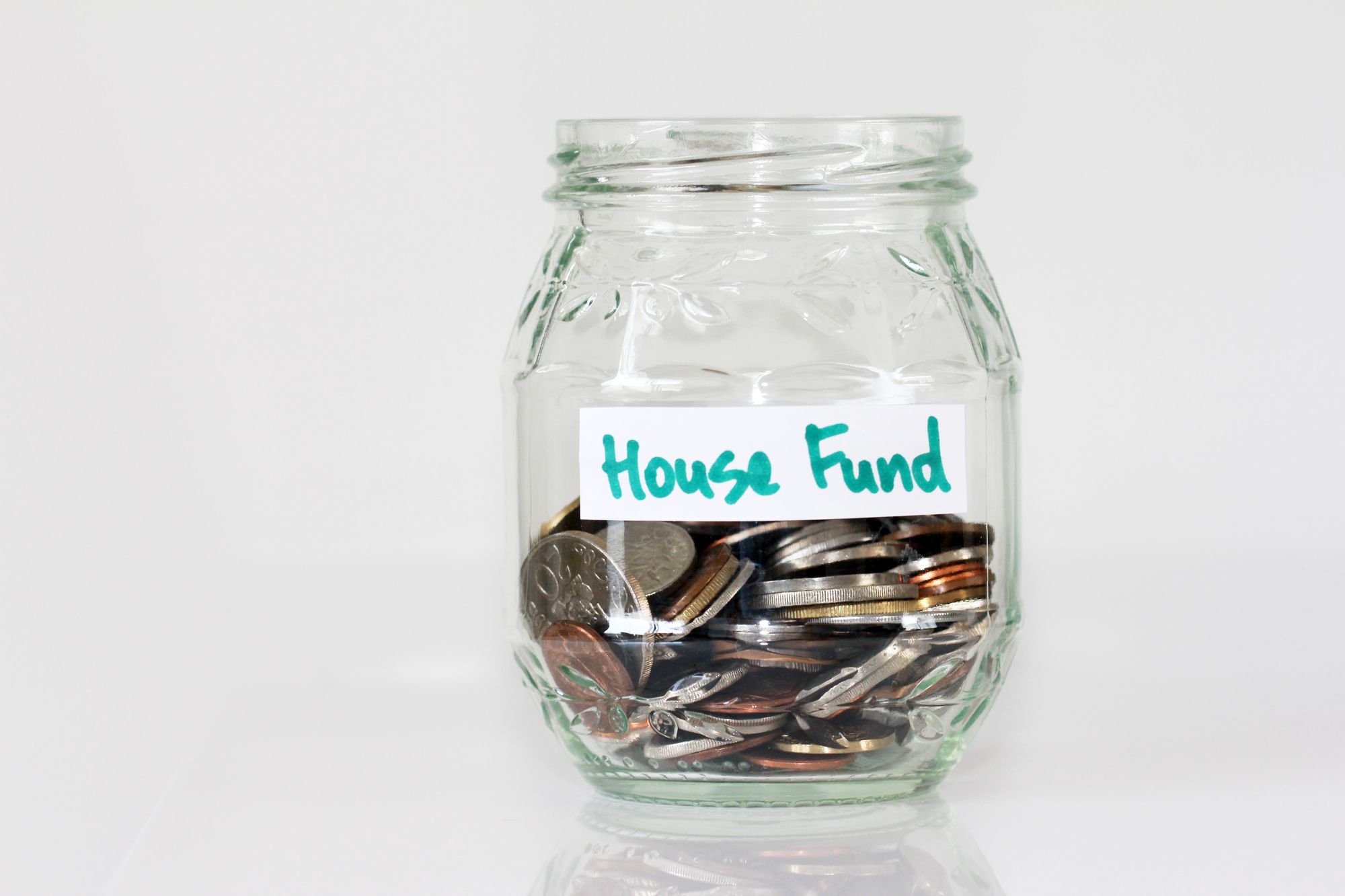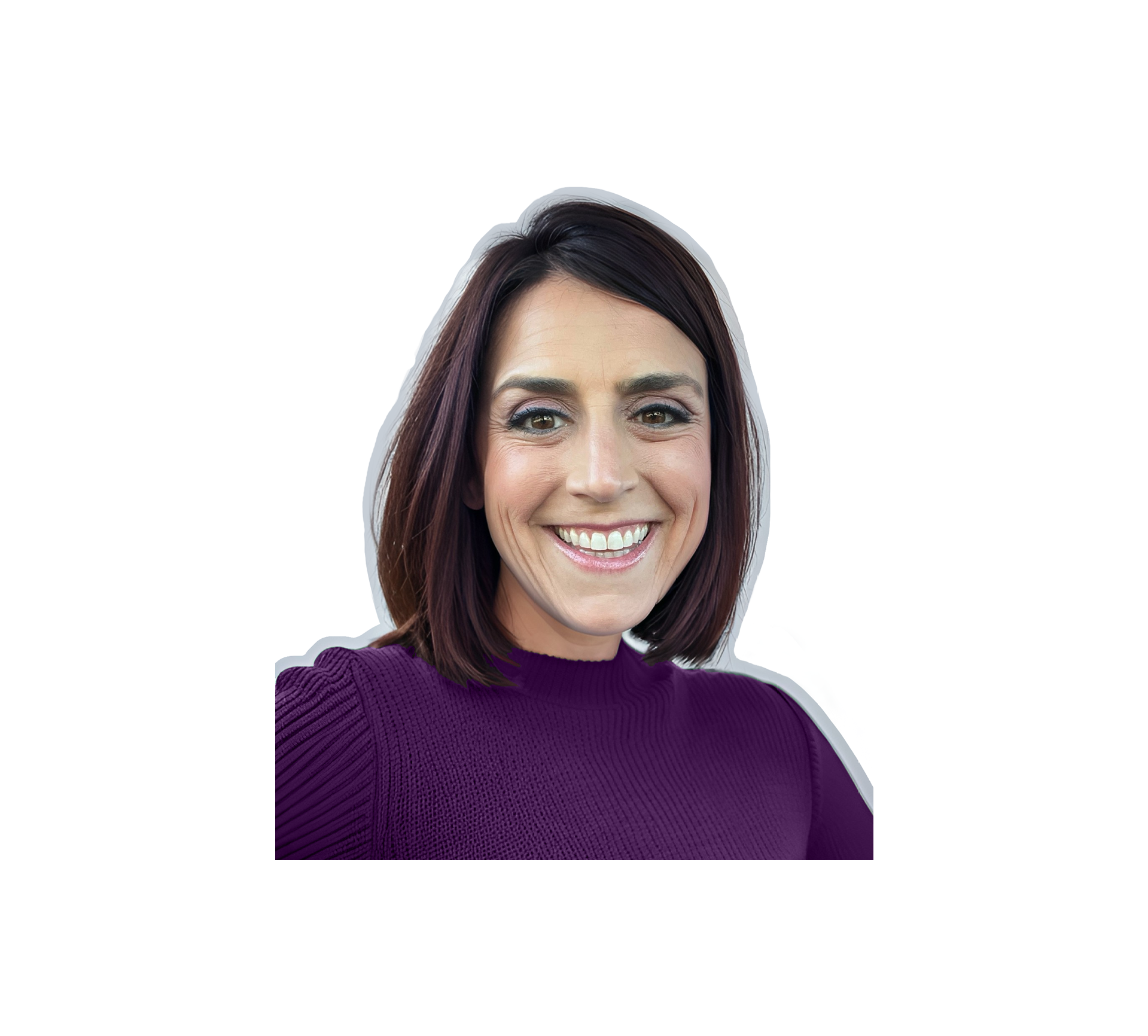Facebook is one of the fastest-growing online advertising platforms today, and that’s no surprise. The average Facebook conversion rate is around 8 percent across industries, which is high compared to other ad networks like Google Ads.
The social media platform also has many daily active users, ad targeting options, and a robust collection of other marketing tools. So if you’re thinking of Facebook advertising or have already decided to start, this resource is for you.
It covers everything you need to know about Facebook conversion rates, how to improve yours, and more so you can confidently run your campaigns.
Also, Facebook rebranded recently to Meta. But this article will use the company’s original brand name to keep things familiar.
What is a conversion rate?
In digital marketing, conversion rate (CVR) is a key metric for measuring the success of ad campaigns. It provides the percentage of visitors (or link clicks related to Facebook) that convert.
For example, enrolling in an online course, joining the email list, downloading a document, etc., are all potential conversion objectives. Typically, big and small businesses will have multiple conversion objectives and create separate ads for each.
To calculate your Facebook conversion rate, add the total number of conversions and divide it by all link clicks. So, for example, the educator creates an online course. They used Facebook to market their course, and the ad led to 22 sales and approximately 1000 link clicks.
The calculation would look like 22 / 1000 x 100 = 2.2 percent.
Your Facebook conversion rate is essential because it helps you manage ad spending and gauge profitability. For example, an ad could lead to 10,000 product sales, but you still lose money because ad spending runs amok. The better your conversion rate, the better the profit.
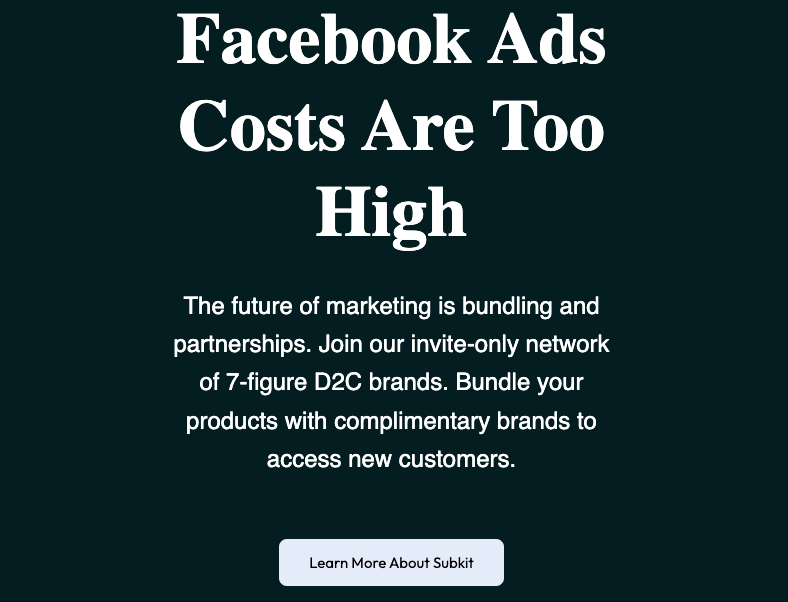
Why advertise on Facebook?
Like any digital marketing ad network, the prime benefit of Facebook advertising is obvious. Solopreneurs and small business owners want new customers, and Facebook has many users and data they can leverage.
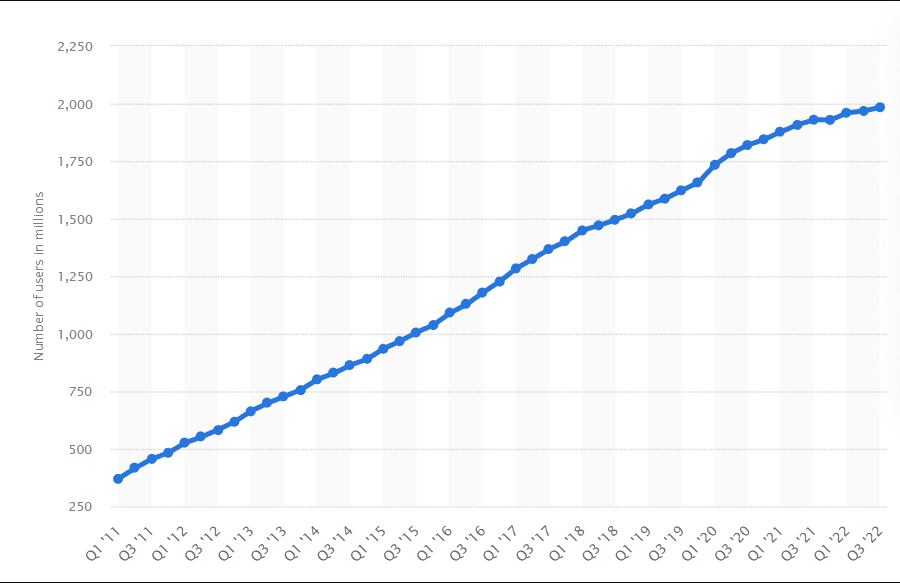
The number of advertisers on the social media network is 3 million. And it has over 2.95 billion monthly active users (MAU), according to Statista
Now that’s a lot of monthly active users, but how many log-in daily - are active users? More than 1.91 billion daily active users. But there are many more reasons to hop on the Facebook bandwagon, so to speak, including the following.
You can micro-target audiences
Facebook is data-rich, practically a treasure trove of information that allows businesses to hone in on their target audience. The precise level of detail makes it possible to narrow down the demographic for every ad.
Great ad types for big and small businesses
Facebook allows advertisers to create creatives that leverage various multi-media elements, such as video, photo, text, etc. And you can pick from multiple ad formats or ad types. Some options aren’t even available in other ad networks.
Every available option also emphasizes branding, which has become more critical in the past year as some economists worry about a potential economic slowdown. Companies that do well with branding tend to fare better in economic downturns, and Facebook, being a highly visual platform, is helpful.
The current ad formats available on Facebook are as follows.
- Photo: The best way to use imagery and copy to engage prospects on the social network.
- Video: Introduce sight, sound, and motion to your Facebook campaign with video ads.
- Stories: This lets you combine video and imagery to create immersive content that tells a story.
- Messenger: Facebook Messenger is more than a customer service tool. It's also great for starting conversations with people about your business or product through ads. It features interactive, automated tools, and you can advertise to current or potential new customers.
- Carousel: With this ad format, you can showcase images or videos (10 max) in a single ad, and each one can have its own link. This is great for highlighting different products or telling a story. The user experience is also slick and intuitive.
- Slideshow: These are video-like ads that make use of multiple images.
- Collection: This ad format is a great way to help the audience discover products. Facebook users can browse items and buy what they want, including clicking to learn more.
- Playable: Use this ad format to show people an interactive preview of your playable product. The try-before-you-buy user experience is most suited for game or app developers.
Facebook has the highest retail ROAS (return on ad spend)
41 percent of surveyed marketers say Facebook provided the best ROAS compared to other social platforms. Facebook users are also highly engaged, making them more likely to click on ads.
Low cost
You can run ads on almost any Facebook ad budget. You can't say that for other networks like Google Ads or LinkedIn.
With Facebook, expect to pay anywhere from 0.40 cents to a few dollars per click. Or $2.50 and above for CPM (cost per 1000 impressions). The average CPM across industries is $14.18, according to Revealbot.
Further, due to Facebook Ads cost, the social network is ideal for promoting brand awareness content like blog posts, infographics, and impressive cornerstone content. Advertising brand awareness content at a lower cost is often a good idea since the ads likely won't generate income immediately.
Built-in A/B ad testing tools
A/B testing is when a business tests two ad variants based on a hypothesis to see which performs best. And Facebook advertising lets you use this kind of split testing with ease.
You can block specific audiences
Facebook Ad features a block list you can use to prevent your ads from appearing in certain places. Essentially, you can avoid any place you don’t consider safe for your brand or Facebook ad campaign.
Places to consider applying a block list include Facebook In-Stream Video, apps in Audience Network, Facebook Reels, and Facebook Instant Articles.
You can send sponsored messages
The sponsored messages feature lets businesses send offers or updates to people who communicate with them on Facebook Messenger, which has 1.3 billion users monthly. Plus, the open rate is 70% better than email marketing, and the engagement is 10 to 80 times better than organic posts.
Good analytics
The company has one of the best analytics tracking systems. There are tons of Facebook metrics to help you understand your ad performance and tweak things for better results.
Key Facebook metrics include:
- Facebook conversion rate
- Facebook impressions & clicks
- Facebook click-through-rate
- Facebook video view rate
Facebook Ads conversion rate and other benchmarks
As far as the numbers to expect for your Facebook conversion rate, it depends on the industry. And the best way to gauge how your Facebook ad campaigns perform is to use benchmarks. These are average conversion rates or results for specific industries that serve as a standard or point of reference to compare or assess other outcomes.
Here are the Facebook ad performance benchmarks or industry averages as per WordStream.
Average Facebook ad conversion rate (CVR)
The following is the average conversion rate across the board.
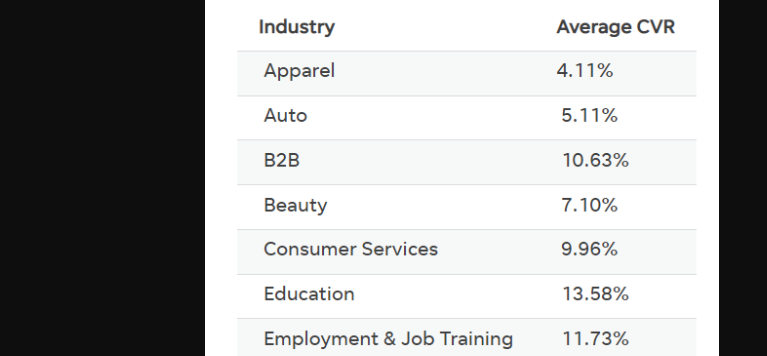
As you see, the average conversion rate varies with different industries.
The fitness industry has the highest conversion rate, reaching 14.29 percent. Second, on the list is the education sector (including coaches and YouTubers) at 13.58 percent. The third industry is Employment and Job Training, with an 11.73 percent Facebook conversion rate.
While some industries see well above the average Facebook conversion rates, others are much lower. However, that doesn't mean they are not profitable. A low conversion rate is sometimes acceptable when the potential customer lifetime value or the product price is significantly great.
Industries like real estate, consumer services, and fitness will generally have higher conversion rates due to the nature of the product or service. And industries like industrial services will have much lower conversion rates for the same reason.
For example, a Fitness ad about losing weight is likely to garner more clicks than something promoting electrical insulators. The main difference is the fitness product has a much bigger audience on Facebook. In contrast, only a few specific groups will be interested in electric insulators.
Adding up all the table numbers and calculating the average gives us an average conversion rate of 7.56 percent across industries. Therefore, businesses should generally expect a 1 to 8 percent Facebook conversion rate.
But use the average conversion rate benchmark for your respective industry as the target to reach or exceed. That’s how you’d know if your Facebook ad campaigns are performing poorly or if you have a good conversion rate.
Also, aside from the average Facebook ad conversion rate, you should be aware of other vital benchmarks, including the following.
Average click-through rate (CTR)
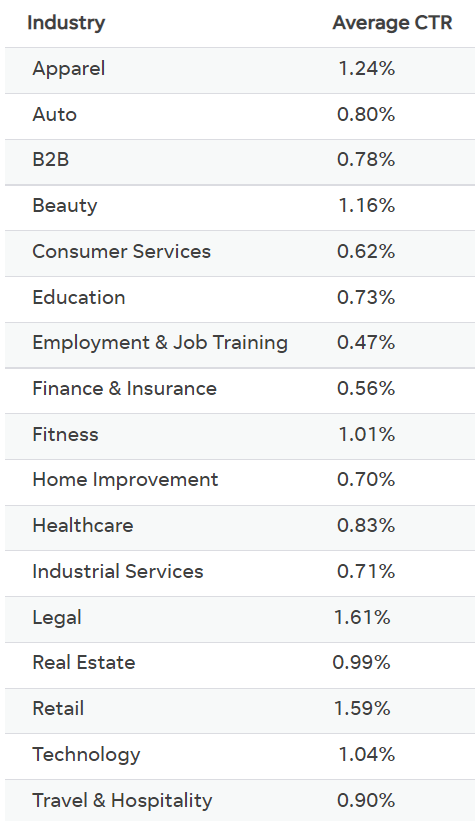
Click-through rate is the number of users who saw your ad and made a link click. You can divide the number of clicks your ad receives by the times it's shown to calculate your click-through rate.
Clicks ÷ impressions x 100 = click-through rate.
So, for example, if you had 100 clicks and 1000 impressions, your click-through rate would be 10 percent.
As per the table, Apparel, Legal Services, and Retail have the highest CTRs or average click-through rates. The rest are either barely above 1 percent or well below.
There are many reasons why an ad will have a low click-through rate. However, the main ones are the competition, unappealing or sub-par visuals, and bad ad copy (spelling, grammar, and message). But you can address all these things with careful attention to detail.
Adding up and dividing the table numbers, the average click-through rate is 0.93 percent across industries.
While that seems low, it’s in line with what’s expected when reaching people who know nothing about your business. Most people won't be ready to buy, and many will hesitate to trust a brand they don't know.

Average cost-per-click (CPC)
Cost-per-click or CPC is an advertising model where advertisers only pay for link clicks instead of impressions or another key metric. For example, spending $1 for every person that clicks your ad.
So what’s a good Facebook cost per click?
For many, it’s whatever allows you to turn a profit.
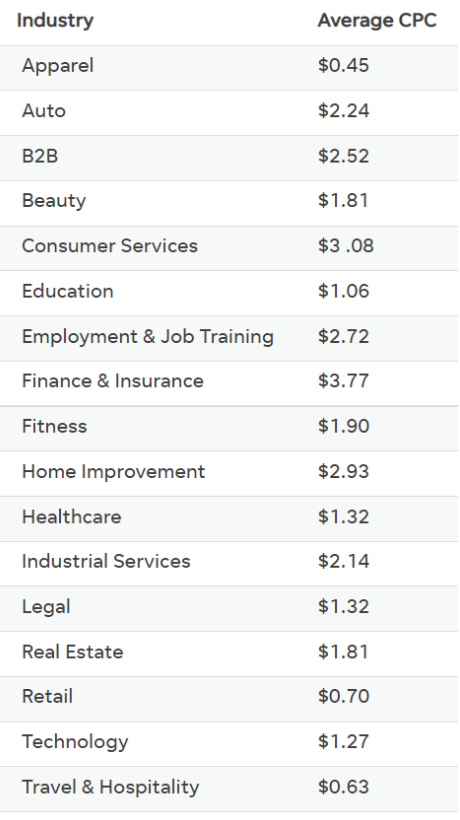
The Finance & Insurance, Consumer Services, and Home Improvement sectors have the highest average click-through rates. Plus, no industry is paying more than $5 per click, illustrating the affordability of Facebook advertising.
When we calculate the numbers, the average cost per click for Facebook Ads is $1.72 across all industries.
Average cost per action (CPA)
Cost per action is a model where ad networks charge advertisers only for a specific action, such as providing contact information, newsletter sign-up, link click, sale, etc.
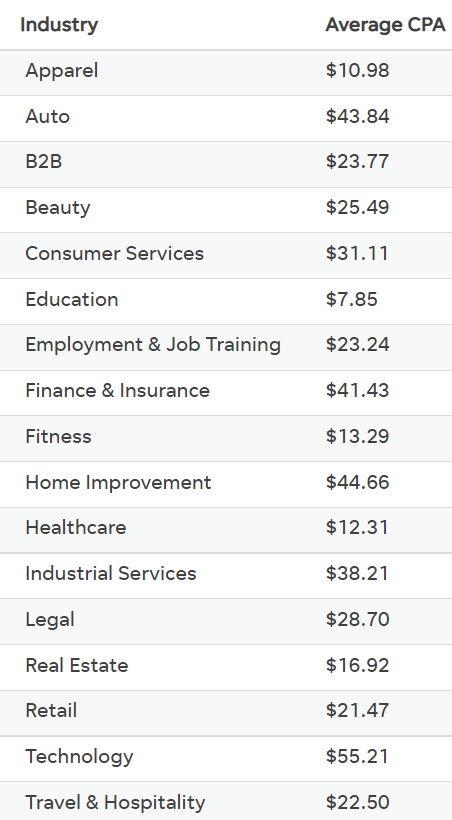
As per the table, the Technology sector has the highest cost per action on Facebook ($55.21), followed by Home Improvement ($44.66). The Auto industry comes third on the list at an average cost per action of $43.84.
Ideally, you should only use cost per action when you know how much a specific action is worth to your business and everything makes sense. For example, paying $50 per action makes sense when the new customer is worth $6,000 to the legal services firm.
The average cost per action across all industries is $27.11, based on the above table.
How to get high conversion rates for Facebook Ads
Creating a compelling ad that drives traffic is one thing; getting those visitors to convert or encouraging them to perform a specific action is another.
Having a successful ad requires fine balancing between your Facebook ad budget, the creative, and the technical.
Here are some tips to help you achieve higher conversion rates on Facebook.
1. Understand and define the target customer
The most vital aspects of Facebook ad success are understanding your audience and targeting.
If you want high conversion rates, take your comprehension of the customer to the next level so that you can target them appropriately on Facebook. Do the research necessary to understand as much as possible (age, gender, income, etc.).
And aside from standard research, you can often grab insights from existing social media profiles, such as your Facebook page. For example, who are the most engaged people on your Facebook page, and what do they have in common?
Also, consider creating buyer personas to help you understand and define the target customer. These are fictional representations of the target audience and can be highly insightful.
Defining your target audience on Facebook
There are three primary ways to define your audience on Facebook. These are Saved Audiences, Custom Audiences, and Lookalike Audiences. Plus, you can define audiences during the Facebook campaign setup and from the Audience section.
With the Audience section, you're saving your targeting options for easy reuse. This is the ideal way to define your target audience.
- Go to Facebook Ads Manager and look for the hamburger icon on the top left to access Audiences.
2. Click ‘Create Audience,' and a dropdown menu will appear with options. Select the type of audience you want to create; from there, it’s straightforward.
Follow the instructions to create your audience, and keep the following in mind.
Saved Audiences
It's about location, user demographics, consumer behaviors, and interests with Saved Audiences.
In other words, you define your target audience by specifying those things to Facebook. The social media platform will then gather the Facebook users that fit your criteria.
Sometimes you’ll find that the audience has millions of Facebook users. For example, the following audience size is too large and too broad.
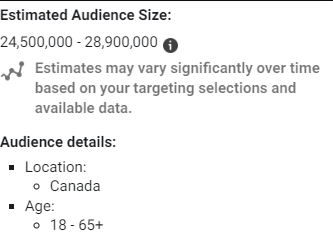
In such cases, narrow the target audience to avoid wasting your marketing budget. Focus on the people that will most likely become customers.
Custom Audiences
Custom Audiences lets you reach out to past customers, prospects, or visitors who have previously engaged with your business. You can create Custom Audiences from your customer contacts, website traffic, mobile app, Facebook page likes, and Messenger engagement.
Also, this audience type is likelier to convert or take a specific action. That's because these people have engaged or interacted with your business before.
Note that you’ll need to install a Facebook Pixel on your website to use it as the base to create a Custom Audience.
Lookalike Audiences
This helps you reach people similar to your existing customers, which can be very powerful. You can make a Lookalike Audience from your Facebook page likes, conversion pixels, and any existing Custom Audiences.
2. Build high-quality landing pages
Your landing page is the web page your target audience visits after clicking the link. It’s an integral part of ad success that shouldn’t be ignored or taken lightly.
But unfortunately, many people drop the ball when it comes to their landing pages. They put a lot of effort into the ad creatives but build sub-par landing pages, which leads to mediocre results.
Instead, work hard on your landing pages and ad creatives equally for better results. Both should encourage users to take the desired action. They should also be similar to help elicit a sense of trust in prospects.
Typically, landing pages that lead to high conversion rates have the following characteristics.
- The design is simple but aesthetically pleasing (aka nice to look at)
- The landing page uses concise, compelling copy
- The value proposition and call-to-action (CTA) are the focus and above the fold.
- The message matches the one on the ad (don’t mislead and use the same brand colors)
- The page content loads fast (e.g., not waiting several minutes to view an image)
- The design is capable of motivating the user to take action (e.g., using directional cues that point toward the most important elements)
- The design is compatible with the right devices (mainly mobile phones, tablets, and desktops)
- There’s social proof that the product or service works (e.g., testimonials, video demonstrations, etc.)
- There are no distractions, such as unnecessary menus, links, etc.
Ads typically fail whenever they combine with poor landing pages. However, when targeting, ad creative, and landing page work well together, the result is usually a good conversion rate.
3. Optimize for mobile devices
Optimizing for mobile devices means ensuring your website or landing page is mobile-friendly. People should be able to click through your Facebook ad and enjoy a pleasant experience on their smartphone, cell phone, tablet, or another mobile device.
But creating a mobile-friendly landing page is quite technical, so you may need professional help. However, some course creation or business platforms like Subkit provide out-of-the-box mobile device-compatible landing pages.
For instance, Subkit's membership hubs strategically focus on the desired action you want the audience to take to help drive up conversion rates.
In general, a mobile-optimized landing page will have the following.
- The fonts or texts are easy to read (no squinting necessary)
- It loads quickly and without compatibility issues
- The design or user interface is intuitive
- The navigation is easy to understand and use
4. Write compelling ad copy
The words you use matter. Words persuade and drive action, but they must simultaneously be relevant, informative, and exciting to work.
Another way to look at it is writing compelling ad copy demands a focus on the target audiences’ needs and wants. That also means you shouldn’t try to speak to all potential customers with one ad copy. Instead, create multiple ads and copy to address all applicable buyer personas.
For example, a success coach with buyer personas for aspiring entrepreneurs and established businesspeople can target each with different ads on Facebook.
Additionally, always lead with value and keep your copy concise, using simple language that anyone can comprehend. Ensure the ad copy aligns with the visual elements and includes at least one call to action.
5. Get your creatives right
Ultimately, the goal of any ad is to grab the target audience's attention.
As it relates to Facebook, you want something that stops someone mid-scroll. Something that makes them take a second look instead of scrolling past. And you can do this with attention-grabbing visuals.
Video content, in particular, remains a powerhouse in Facebook marketing. 47 percent of consumers watch video ads primarily on Facebook. Plus, the average engagement rate for video posts on the social media platform is around 6 percent.
6. Use clear call-to-actions
What do you want the potential customer to do? Is your call to action conveying that well? Your headline grabs the user’s attention, the ad copy persuades, and the call-to-action directs them to take the desired action.
Promote a high-value action that's low-risk to the target audience for best results.
Some examples of great call-to-actions include:
- Show Me My Audit
- Build Your Website
- Enroll Now
- Talk To Us
- Let’s Get Started
- Start Your Free Trial
- Learn More
- Get In Touch
- Give Us A Try
- Join Us
- Shop Now
- Subscribe
- Sign Up
- Be Awesome
- Swipe For a Free Trial
7. Watch for ad fatigue
Ad fatigue is when creatives lose their effectiveness after multiple views from an audience. In other words, the audience eventually gets bored and stops paying attention, making your Facebook ad campaign much less effective.
The good news is you can do a few things to avoid ad fatigue, including the following.
- Refresh your ad copy and visuals when performance dips
- Use an ad set with multiple creatives
- Exclude customers who already took the desired specific action
- Reduce the frequency of your ad
- Start using different ad placements
8. A/B test your ads
Touched on earlier, one way to improve your Facebook Ads conversion rate is through A/B testing or split testing. Facebook has many A/B Testing options, and you can test various things, including audience, placement, and creative variables.
When you use the A/B test, Facebook shows a segment of the audience your ad but ensures no one ever sees both variants. You can then compare the results to determine the best-performing ad.
But when should you A/B test?
If you want to measure the impact of changes to your advertising strategy or compare two tactics quickly, A/B testing can be helpful. However, be sure to have a hypothesis before choosing variables to test.
For example, you may hypothesize your ad will perform better with audience members that are 40+ years old. With that hypothesis, testing can do much to improve your outcomes since it provides guidance.
You should also use the same budget for the variants in a test. This is to ensure a fair comparison and avoid testing informally. For instance, manually turning ad sets or campaigns on and off is informal testing. Such tests often lead to unreliable results.
The ideal A/B test is when audiences are evenly split and statistically comparable.
Factors that will impact your Facebook conversion rate
The following factors will influence your Facebook conversion rate the most.
B2B or B2C
Are you going after a business-to-business (B2B) or business-to-customer (B2C) audience? Your Facebook Ads conversion rates will look different depending on the target audience.
But in general, converting B2B customers is more complex than B2C on Facebook due to the social media platform’s nature. Nevertheless, the value of a B2B customer is often much higher, and they typically stick with brands longer.
Your product prices
When the product price is low, impulse buying behaviors are common. But when the price is high, people are more likely to consider purchasing decisions carefully. Therefore, you should approach high-ticket items differently.
For example, rather than asking the audience for 'the sale' immediately, focus on easing the potential customer journey. Guide them through the process required to make an informed decision.
The market and competition
It’s harder and more expensive to penetrate a saturated market, so figure out how to stand out from the competition. Good market research should provide all the answers you need. For instance, you may identify a new, untapped way of reaching your target audience through research.
The place you put your ads
Do your ad copy and creative work for where customers will see your ad?
For example, ads on the Facebook Feed should have aspects that encourage engagement so users don’t scroll past. This can be a shocking image, inspiring statement, meme, product picture, video content, etc.
Knowing how customers are likely to behave while accessing certain areas on Facebook can improve your ad performance.
Target country or location
This one is a no-brainer. The right people from the right locations must see your ad at the right time. However, keep in mind that the location may not be a factor for some products.
Your campaign objective
What is your conversion objective, and does it make sense? For instance, a B2B audience is likelier to download a free guide than open their wallets on the first engagement. So consider your conversion objective for all ads and ensure they align with essential factors about the audience.
Your conversion rate will probably be low if objectives aren’t appropriate.
Onward to your Facebook Ads success
Whether you’re a business owner, executive, or social media marketer, there’s no denying that Facebook is one of the largest ad and social networks. The sheer number of active users means you have the potential to reach millions of people, rivaling Google AdWords. And a high Facebook conversion rate is key to profitability.
But achieving a high conversion rate involves knowing the correct benchmarks and learning about your target audience in intricate detail. It also involves knowing the factors likely to influence your ad, including the market, demographic targeting, and product price.
If you find yourself performing below the benchmark numbers, that means there's much room to improve. And one of the best ways to do that is to A/B test different hypotheses.
A successful ad gets people to buy your product or service. So if yours isn't converting, keep testing things until you get it right. Most businesses can afford to run A/B tests since Facebook Ad costs are the lowest among major ad networks.
Lastly, find a platform like Subkit that facilitates high conversions right off the bat. This will eliminate much work on your part, help ensure a smooth Facebook ad campaign that reaches the right people, and impact total revenue positively. Get access to Subkit.

